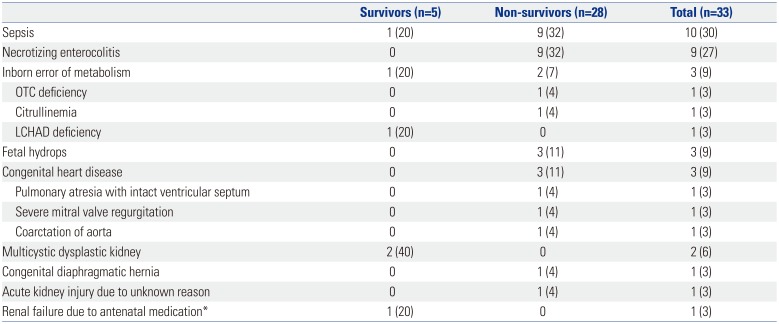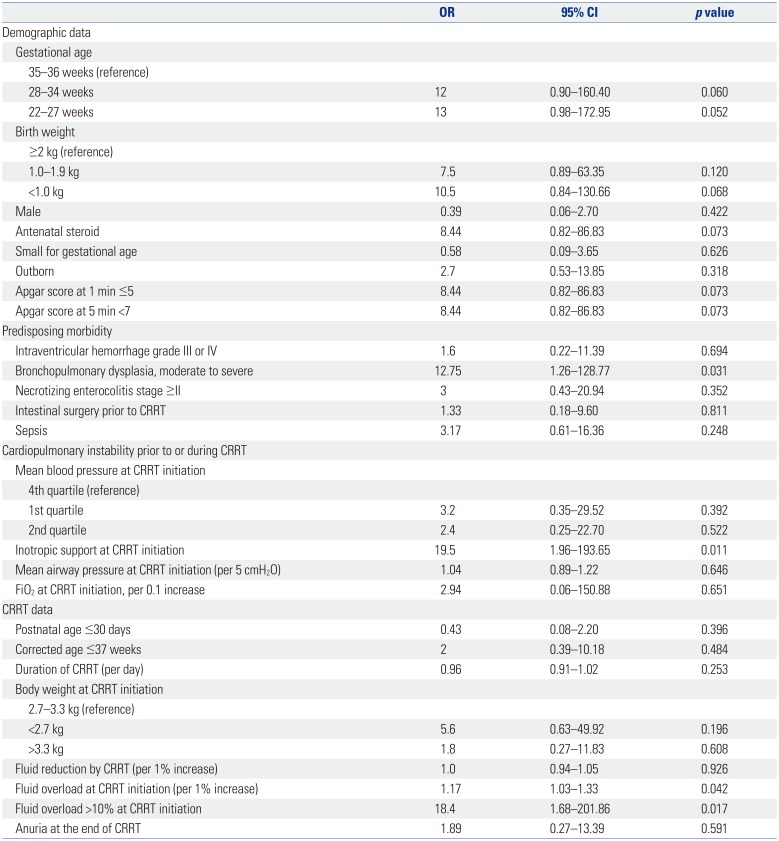1. Stoll BJ, Hansen NI, Bell EF, Walsh MC, Carlo WA, Shankaran S, et al. Trends in care practices, morbidity, and mortality of extremely preterm neonates, 1993–2012. JAMA. 2015; 314:1039–1051. PMID:
26348753.

2. Kim JK, Chang YS, Sung S, Ahn SY, Yoo HS, Park WS. Trends in survival and incidence of bronchopulmonary dysplasia in extremely preterm infants at 23–26 weeks gestation. J Korean Med Sci. 2016; 31:423–429. PMID:
26955244.

3. Kaddourah A, Goldstein SL. Renal replacement therapy in neonates. Clin Perinatol. 2014; 41:517–527. PMID:
25155724.

4. van Stralen KJ, Borzych-Duz ·, Hataya H, Kennedy SE, Jager KJ, Verrina E, et al. Survival and clinical outcomes of children starting renal replacement therapy in the neonatal period. Kidney Int. 2014; 86:168–174. PMID:
24499775.

5. Teh JC, Frieling ML, Sienna JL, Geary DF. Attitudes of caregivers to management of end-stage renal disease in infants. Perit Dial Int. 2011; 31:459–465. PMID:
21454396.

6. Ponikvar R, Kandus A, Urbancic A, Kornhauser AG, Primozic J, Ponikvar JB. Continuous renal replacement therapy and plasma exchange in newborns and infants. Artif Organs. 2002; 26:163–168. PMID:
11879246.

7. White CT, Gowrishankar M, Feber J, Yiu V. Canadian Association of Pediatric Nephrologists (CAPN). Peritoneal Dialysis Working Group. Clinical practice guidelines for pediatric peritoneal dialysis. Pediatr Nephrol. 2006; 21:1059–1066. PMID:
16819641.

8. Tal L, Angelo JR, Akcan-Arikan A. Neonatal extracorporeal renal replacement therapy-a routine renal support modality? Pediatr Nephrol. 2016; 31:2013–2015. PMID:
27270721.

9. Ronco C, Bonello M, Bordoni V, Ricci Z, D'Intini V, Bellomo R, et al. Extracorporeal therapies in non-renal disease: treatment of sepsis and the peak concentration hypothesis. Blood Purif. 2004; 22:164–174. PMID:
14732825.

10. Leyh RG, Nötzold A, Kraatz EG, Sievers HH, Bernhard A. Continuous venovenous haemofiltration in neonates with renal insufficiency resulting from low cardiac output syndrome after cardiac surgery. Cardiovasc Surg. 1996; 4:520–525. PMID:
8866094.

11. Picca S, Dionisi-Vici C, Abeni D, Pastore A, Rizzo C, Orzalesi M, et al. Extracorporeal dialysis in neonatal hyperammonemia: modalities and prognostic indicators. Pediatr Nephrol. 2001; 16:862–867. PMID:
11685590.

12. Schröder CH, Severijnen RS, Potting CM. Continuous arteriovenous hemofiltration (CAVH) in a premature newborn as treatment of overhydration and hyperkalemia due to sepsis. Eur J Pediatr Surg. 1992; 2:368–369. PMID:
1477068.

13. Westrope C, Morris K, Burford D, Morrison G. Continuous hemofiltration in the control of neonatal hyperammonemia: a 10-year experience. Pediatr Nephrol. 2010; 25:1725–1730. PMID:
20495829.

14. Schwartz GJ, Brion LP, Spitzer A. The use of plasma creatinine concentration for estimating glomerular filtration rate in infants, children, and adolescents. Pediatr Clin North Am. 1987; 34:571–590. PMID:
3588043.

15. Ronco C, Garzotto F, Brendolan A, Zanella M, Bellettato M, Vedovato S, et al. Continuous renal replacement therapy in neonates and small infants: development and first-in-human use of a miniaturised machine (CARPEDIEM). Lancet. 2014; 383:1807–1813. PMID:
24856026.

16. Al Malla M, Varghese NV, AlAbdullatif M, Narchi H, Khassawneh M. Prevalence and outcome of acute kidney injury, as defined by the new Kidney Disease Improving Global Outcomes guideline, in very low birth weight infants. World J Nephrol. 2017; 6:229–235. PMID:
28948160.
17. Askenazi D, Saeidi B, Koralkar R, Ambalavanan N, Griffin RL. Acute changes in fluid status affect the incidence, associative clinical outcomes, and urine biomarker performance in premature infants with acute kidney injury. Pediatr Nephrol. 2016; 31:843–851. PMID:
26572893.

18. Selewski DT, Cornell TT, Lombel RM, Blatt NB, Han YY, Mottes T, et al. Weight-based determination of fluid overload status and mortality in pediatric intensive care unit patients requiring continuous renal replacement therapy. Intensive Care Med. 2011; 37:1166–1173. PMID:
21533569.

19. Vuohelainen T, Ojala R, Virtanen A, Korhonen P, Luukkaala T, Holm P, et al. Decreased free water clearance is associated with worse respiratory outcomes in premature infants. PLoS One. 2011; 6:e16995. PMID:
21347330.

20. Sutherland SM, Zappitelli M, Alexander SR, Chua AN, Brophy PD, Bunchman TE, et al. Fluid overload and mortality in children receiving continuous renal replacement therapy: the prospective pediatric continuous renal replacement therapy registry. Am J Kidney Dis. 2010; 55:316–325. PMID:
20042260.

21. Lee ST, Cho H. Fluid overload and outcomes in neonates receiving continuous renal replacement therapy. Pediatr Nephrol. 2016; 31:2145–2152. PMID:
26975386.

22. Askenazi DJ, Goldstein SL, Koralkar R, Fortenberry J, Baum M, Hackbarth R, et al. Continuous renal replacement therapy for children ≤10 kg: a report from the prospective pediatric continuous renal replacement therapy registry. J Pediatr. 2013; 162:587–592. PMID:
23102589.

23. Santiago MJ, López-Herce J, Urbano J, Solana MJ, del Castillo J, Ballestero Y, et al. Complications of continuous renal replacement therapy in critically ill children: a prospective observational evaluation study. Crit Care. 2009; 13:R184. PMID:
19925648.

24. Diane Mok TY, Tseng MH, Chiang MC, Lin JL, Chu SM, Hsu JF, et al. Renal replacement therapy in the neonatal intensive care unit. Pediatr Neonatol. 2018; 59:474–480. PMID:
29396136.








 PDF
PDF ePub
ePub Citation
Citation Print
Print



 XML Download
XML Download